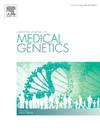The craniofacial, dental and systemic manifestations of Enamel Renal Syndrome: A Scoping review
IF 1.7
4区 医学
Q3 GENETICS & HEREDITY
引用次数: 0
Abstract
Introduction
Enamel Renal Syndrome (ERS) (OMIM 204690) is a rare genetic condition characterised by a distinct oral profile and sometimes nephrocalcinosis. This autosomal recessive condition, caused by pathogenic variants in the FAM20A gene, is linked to ectopic mineralisation in tissues such as dental pulp, follicles, gingiva, and kidneys. Although the oral phenotype has been well-characterised, less common features have been described, highlighting possible gaps in the literature on the phenotypic variability of the condition.
Methods
This scoping review follows PRISMA-ScR guidelines and aimed to synthesise existing literature on ERS, focusing on clinical and radiographic features, oral histology, systemic manifestations, and molecular findings. A comprehensive search was conducted in multiple databases, with inclusion criteria broad enough to capture relevant studies under various nomenclatures. The screening process involved independent review and data extraction with a custom tool.
Results
The initial search yielded 430 references, supplemented by additional publications identified through Google Scholar and citation searching. After removing duplicates and resolving inter-rater discrepancies, 62 studies were included, encompassing a diverse global sample. Publications spanned from the first report in 1972 to recent studies in 2024. The included studies highlight the characteristic oral profile of ERS and less consistently reported renal manifestations. While the pathognomonic oral profile remains consistent, long-term studies are required to fully understand renal and systemic impacts. Current management strategies are patient-specific, with a need for standardised reporting and long-term follow-up to develop evidence-based guidelines. Until more comprehensive data is available, vigilant monitoring of kidney function in ERS patients remains essential.
Conclusion
This review confirms that ERS presents with a distinct oral and dental profile. However, inconsistencies in the reporting of craniofacial, renal, and other systemic features were noted. To improve patient care, further research is essential to better understand the systemic implications and long-term outcomes of ERS. This will support the development of evidence-based guidelines and foster a more holistic approach to managing the condition.
牙釉质肾综合征的颅面、牙齿和全身表现:范围回顾。
釉质肾综合征(ERS) (OMIM 204690)是一种罕见的遗传性疾病,其特征是口腔特征明显,有时伴有肾钙质沉着症。这种常染色体隐性遗传病是由FAM20A基因的致病变异引起的,与牙髓、卵泡、牙龈和肾脏等组织的异位矿化有关。尽管口腔表型已被很好地表征,但已描述了不太常见的特征,突出了该病症表型变异性的文献中可能存在的空白。方法:本综述遵循PRISMA-ScR指南,旨在综合现有关于ERS的文献,重点关注临床和影像学特征、口腔组织学、系统表现和分子发现。在多个数据库中进行了全面的搜索,纳入标准足够广泛,可以捕获各种命名下的相关研究。筛选过程包括使用定制工具进行独立审查和数据提取。结果:最初的搜索产生了430篇参考文献,通过b谷歌Scholar和引文搜索发现了额外的出版物。在去除重复项并解决评分者之间的差异后,纳入了62项研究,涵盖了不同的全球样本。发表的报告从1972年的第一份报告到2024年的最新研究。纳入的研究强调了ERS的口腔特征和较少一致报道的肾脏表现。虽然口腔病理特征保持一致,但需要长期研究来充分了解肾脏和全身影响。目前的管理策略是针对患者的,需要标准化报告和长期随访,以制定循证指南。在获得更全面的数据之前,对ERS患者的肾功能进行警惕监测仍然是必要的。结论:这篇综述证实了ERS具有独特的口腔和牙齿特征。然而,颅面、肾脏和其他系统特征的报道不一致。为了改善患者护理,进一步的研究是必要的,以更好地了解ERS的系统影响和长期结果。这将支持以证据为基础的指导方针的发展,并促进更全面的方法来管理这种情况。
本文章由计算机程序翻译,如有差异,请以英文原文为准。
求助全文
约1分钟内获得全文
求助全文
来源期刊
CiteScore
4.10
自引率
0.00%
发文量
193
审稿时长
66 days
期刊介绍:
The European Journal of Medical Genetics (EJMG) is a peer-reviewed journal that publishes articles in English on various aspects of human and medical genetics and of the genetics of experimental models.
Original clinical and experimental research articles, short clinical reports, review articles and letters to the editor are welcome on topics such as :
• Dysmorphology and syndrome delineation
• Molecular genetics and molecular cytogenetics of inherited disorders
• Clinical applications of genomics and nextgen sequencing technologies
• Syndromal cancer genetics
• Behavioral genetics
• Community genetics
• Fetal pathology and prenatal diagnosis
• Genetic counseling.

 求助内容:
求助内容: 应助结果提醒方式:
应助结果提醒方式:


